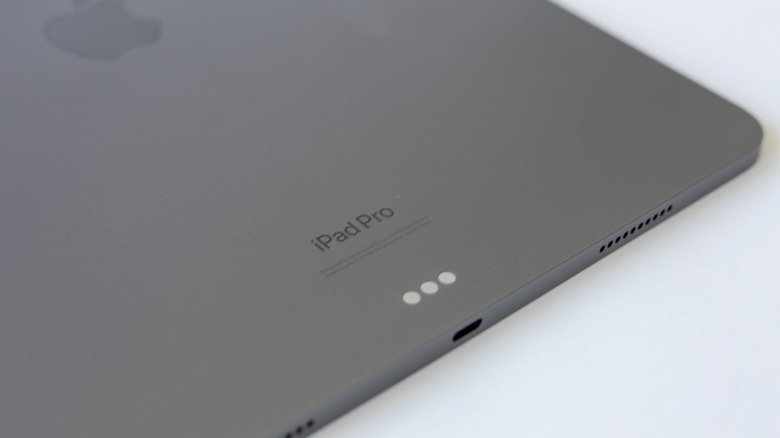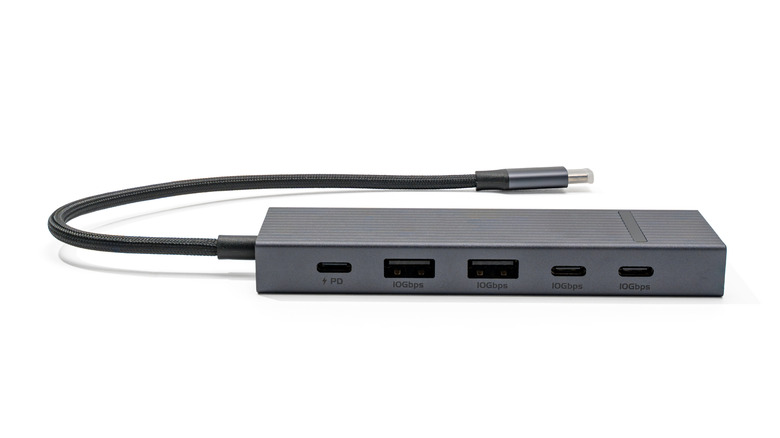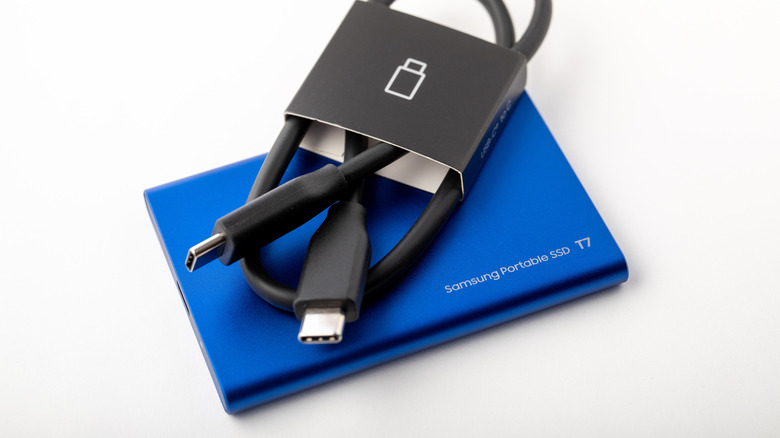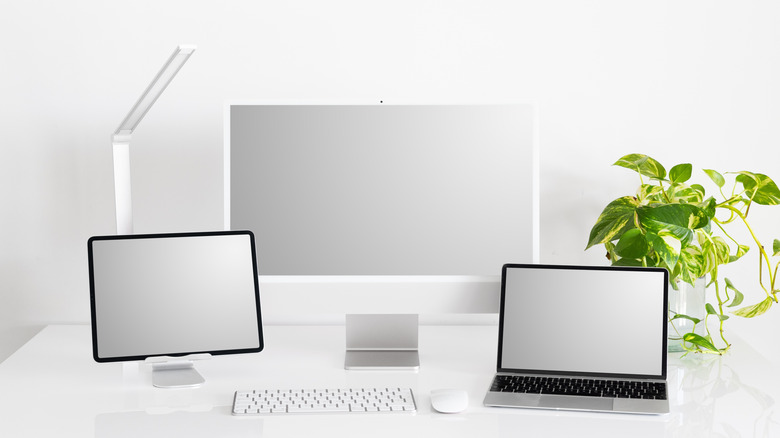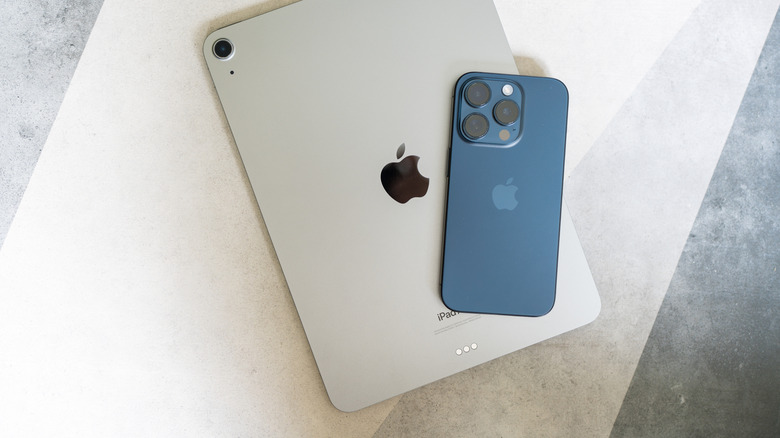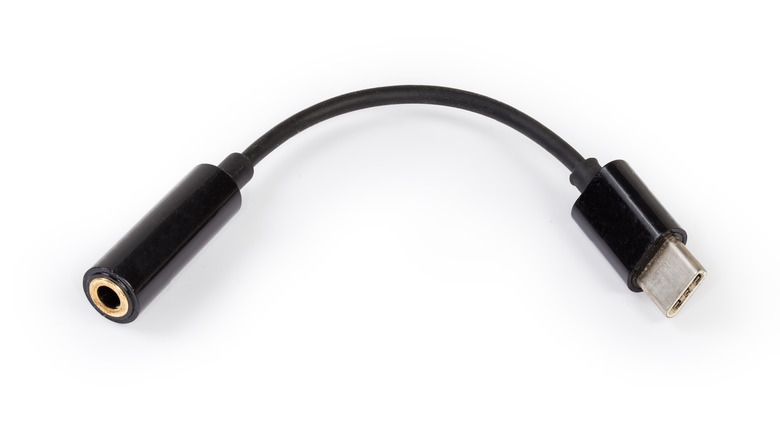5 Uses For Your iPad's USB-C Port
We may receive a commission on purchases made from links.
For years, the number one question people asked about the iPad was if it could really replace your Mac. That answer was always no, not really. It was always a sort of oversized iPhone that excelled at neither iPhone tasks nor Mac tasks, consigning it to being a very expensive Netflix machine. Until today. iPadOS 26 brings a number of key features that users had been begging for since the tablet's inception. Desktop-like window management? Check. Better file app? Check. Running background tasks without having to keep the app in focus? Check. The list goes on, making this arguably the iPad's best year so far. Key to helping it embrace its new laptop-killer role is making the most of the single USB-C port.
When people think of the most useful iPad accessories you can buy, it probably boils down to an attachable keyboard, the Apple Pencil for drawing, and maybe a power bank to keep it juiced up. Those will definitely be essentials once iPadOS 26 drops, but the USB-C port can do quite a bit more. To show you, let's take a look at five uses for your iPad's USB-C port that you might not have known about.
Connecting to a USB hub
It doesn't matter what the iPad's USB-C port can do if you can only plug in one thing at a time — or can't plug in the things you need. MicroSD cards, Ethernet ports, headphone jacks, and USB-A all require a USB-C hub. Apple supports these, and since it doesn't sell its own version, any hub that supports the iPad is at your disposal. There's a good chance an old USB-C hub you have lying around will still work just fine for your purposes. If you'd rather have something that doesn't dangle perilously from your expensive tablet, we have better recommendations.
The best all-rounder is something like this 7-in-1 USB-C hub adapter. It includes two USB-C ports, one USB-A port, one HDMI port, and a headphone audio jack. Since it's designed to plug in and lie flush against the bottom of your iPad, it's the perfect portable solution. The little grips keep it from getting bumped and damaging your iPad's USB-C port. For something more premium that doesn't come from a no-name brand, the Anker 6-in-1 USB-C hub is also a good choice. Both options (or anything similar) are usually slim enough to avoid interfering with your case and may even fit inside a carry case without removal.
If iPadOS 26 has made you a believer in this laptop-replacement idea, then we recommend something more like the Satechi USB-C hub. It's a sleek aluminum stand with various I/O squirreled away out of sight. If you plan to use the iPad with an external monitor (another possibility we'll discuss), this is a good choice. Note that there's a difference between USB hubs and USB docks, so search the right term to get the correct results.
Storing files on an external hard drive
The iPad supports external storage devices like thumbsticks and portable hard drives. So you can skip Apple's egregious storage upgrade costs, buy a base model, and use the savings on a large-capacity drive. USB-C thumb drives are cheap these days; a 256GB Samsung Type-C USB flash drive costs only $32.99. The fastest portable SSDs you can buy for your laptop will also likely work with the iPad. Newer external media tends to be USB-C, so upgrade to a SanDisk Extreme Portable SSD if you can. If you have a USB-A drive, this gives you another excuse to get a USB hub.
So what do you use all that storage for? If you've got any of the M-Series iPad Pros, then you'll know they're deceptively thin, fanless powerhouses capable of manipulating hi-def images in Photoshop and Pixelmator, exporting video in Final Cut Pro, or making music in Logic Pro. Those big file sizes for ProRes footage or WAV audio files are going to fill up an iPad quickly. Camera footage is another consideration. If you're one of the few people who actually use the iPad's back camera, an external drive can pick up the slack when filming.
Another thing to keep in mind is USB and Thunderbolt transfer speeds. The latest 2024 iPad Pro M4 supports Thunderbolt 3 and USB 4 up to 40 gigabits per second. Buying a drive that isn't up to snuff means you won't be seeing those blazing-fast transfer speeds. Consider investing a bit more if that matters to you. The cream of the crop transfer speeds will also have their own increased power demands; prepare for extra drain when using Thunderbolt, and get into the habit of unplugging your external hard drive when you're not using it.
Using an external monitor (or USB-C capture card)
iPads also support external displays. The lowly iPad mini can output 4K, and the later generations of the Pro and Air support up to 6K on a Pro Display XDR. So, just as we mentioned earlier, something like the Satechi stand/docking station combination could really make your iPad a desktop PC competitor. The iPad also supports HDR on screens that support it. Having said that, there's one big fly in the ointment: The iPad can only duplicate its screen. Only certain apps that support a second screen will allow you to use the external screen as an extended display.
Another lesser-known possibility for the iPad is turning it into an external screen itself. Using something like the Orion app and a USB-C capture card, the iPad becomes a self-powered external display. USB capture cards are cheap. You can grab this Guermok 4K USB-C capture card for $18.99. The iPad then becomes an excellent portable screen for a handheld gaming PC like the Steam Deck OLED when you're away from home. Most gaming handheld PCs have a 7-8 inch screen, which is great in handheld mode but not ideal if you want to kick back.
Some caveats are worth noting here. One, the iPad's screen resolution may not match up with your source, such as a Steam Deck. Expect thick black bars at the top and bottom of the screen. Two, a lot of users experience input latency due to their capture card. This could exacerbate existing input latency from wireless controllers and translation layers — an annoyance that can make some games unplayable, especially if they're competitive and/or fast-paced games. Do keep in mind that the iPad can also work wirelessly as a second display for a Mac via Sidecar.
Charging other devices
One feature iPad models consistently receive praise for is their long battery life. Even the ultra-slim iPad Pro M4 manages approximately 10 hours of screen-on time, depending on what you're doing. That's potentially more battery than you need for a device that's not used as much as your phone, especially while traveling. Perhaps one of the lesser-known features of the iPad is that it's capable of reverse charging. The 11-inch iPad Pro has a huge 31.29Wh battery, which dwarfs your phone's battery. You could buy one of the fastest power banks for charging your phone during your next trip, or in a pinch, use the iPad you already brought with you.
The challenge here will be getting the right cable. Wonderful as the USB-C standard is, not all USB-C cables are the same. Make sure the cable is up to the job, even if your iPad will be charging another USB-C device. Things may get complicated when finding a USB-C-to-Lightning cable for an older iPhone that supports reverse charging.
Reverse charging works for iPads and Apple Watches too. In the case of the iPad, the wrong device may end up charging. You may have to do some plugging and unplugging to fix this; Apple says the only way to change which iPad becomes the charger and which becomes the leech is by unplugging both devices and then plugging them back in again.
Listening to hi-fi audio
Apple added lossless music audio for free to Apple Music subscribers back in 2021. Lossless audio is supported on most of Apple's devices, including the iPad. Great news, but there was one wrinkle: Apple removed the headphone jack on its mobile devices years ago, including the iPad. That new hi-fi potential is therefore wasted. Bluetooth devices do sound pretty good compared to wired ones, to be fair, but normal Bluetooth simply cannot transmit lossless audio. It was a step forward and a step back for Apple-using audiophiles. What's the workaround? A USB-C headphone jack dongle.
Even cheap adapters can output hi-fi audio. This JSAUX USB-C 3.5mm headphone jack adapter costs $5.97. Of course, this will prevent you from listening to music and charging your device at the same time unless you buy an adapter with both. The Subynanal USB-C 3.5mm adapter adds a female USB-C connector, unsightly and unwieldy though the extra hanging dongle may be. Granted, listening to lossless music has always been more of a home experience. You need a quiet place to hear all the little details, so the adapter solution in that setting isn't much of a sacrifice.
If the fact that you once could plug wired headphones into your iPad — but now can't — depresses you, then there's hope on the horizon. Wireless lossless standards already exist on Android. Apple has developed a low-latency, wireless lossless audio standard to compete, although it currently only works with the Apple Vision Pro. It's safe to assume something similar is coming for the entire lineup, including iPads, though of course, this is Apple we're talking about, so it's probably going to be exclusive to its AirPods.
